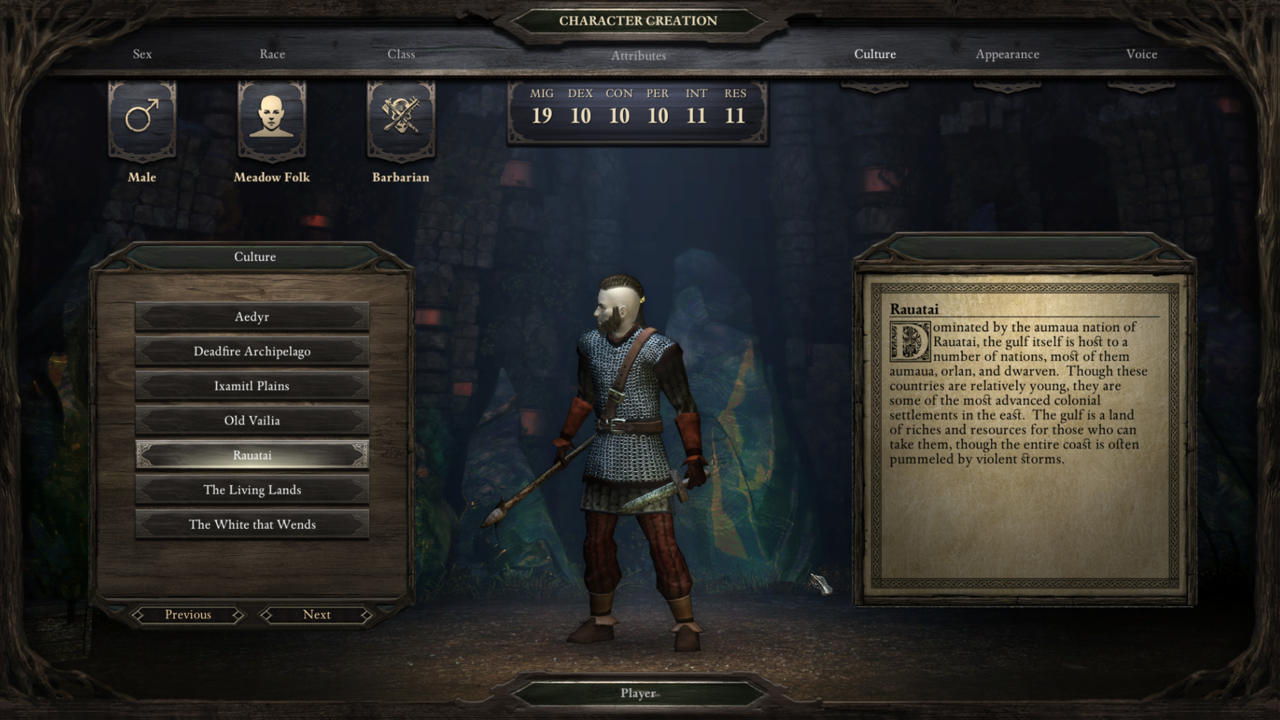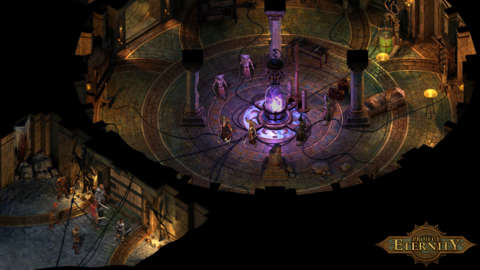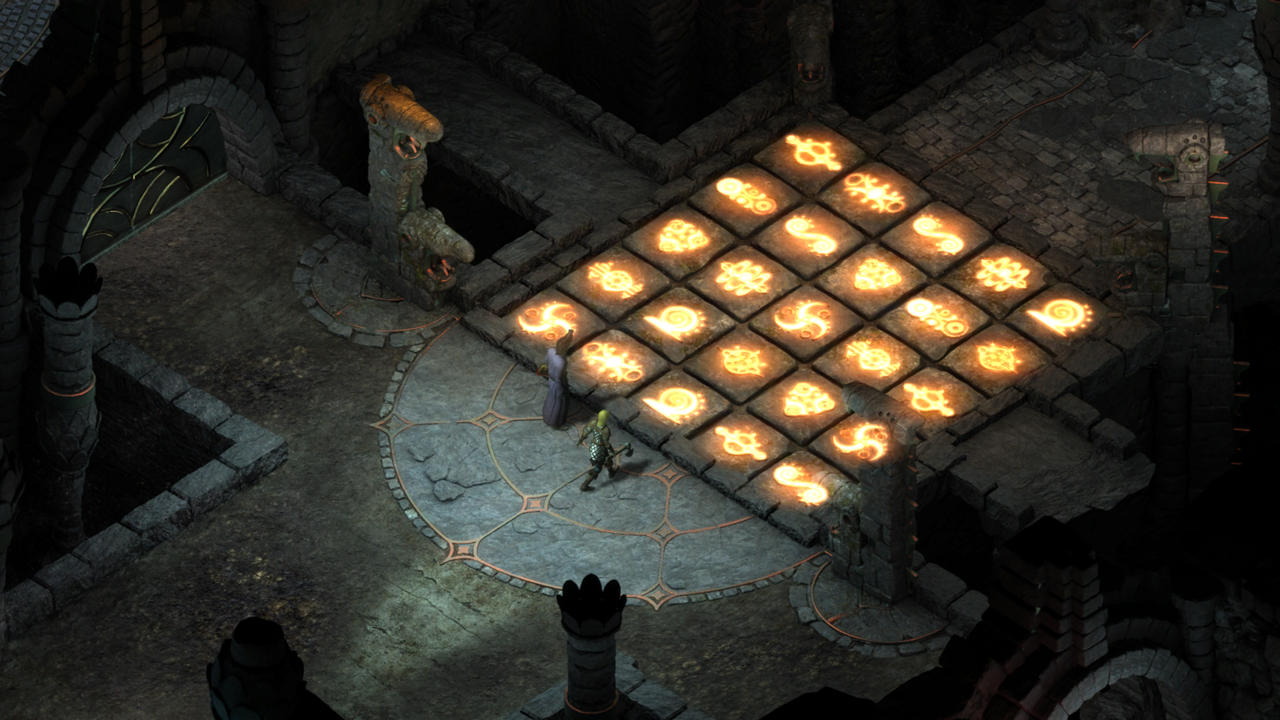It's said that we stand on the shoulders of giants--that is, that we advance into the future by building on the grand discoveries that have come before. Modern role-playing games, for example, stand on the shoulders of adventures like Ultima VII, Eye of the Beholder, Baldur's Gate, and Planescape: Torment. Developer Obsidian Entertainment, well-known for RPGs ranging from Knights of the Old Republic II to Alpha Protocol, knows its history. And with Pillars of Eternity, it hopes to recapture a piece of it.
Whether or not Pillars of Eternity has the same magic as Baldur's Gate, the game which it clearly looks upon with awe and reverence, isn't yet clear. Several members of the game's development team showed off the game to me recently, and it only took a single glance to see that Pillars of Eternity is spawned from BioWare's classic. It doesn't take place in the Dungeons & Dragons universe, but Pillars nonetheless looks and feels like its inspiration. The environments have that hand-drawn grittiness that gave the Infinity Engine games an air of fantastical despair, the interface looks as if it has been carved from oak and stone, and selected party members are identified with pulsing blue circles under their feet. Combat is even in the pause-and-play style that serves as Baldur's Gate's signature.

As I watched Obsidian play Pillars of Eternity, it was hard not to shake the concern that stayed with me throughout the demo: that this was not a game standing on the shoulders of giants, but one relying on slavish devotion. It didn't help that I had just played the excellent Divinity: Original Sin earlier that day, an RPG that uses its inspirations as a springboard rather than as a mold, and in the process establishes an identity that makes it an important step in RPG evolution. Divinity uses old mechanics to say something new. Does Pillars of Eternity use old mechanics to say something old? And if so, is that necessarily a bad thing?
Pillars of Eternity project director Josh Sawyer doesn't think so. We chatted a bit about the Baldur's Gate legacy, and the ways Obsidian plans to differentiate their game from its forebears. And for Sawyer, a big part of that is rethinking how classes function. "I worked on all the Icewind Dale games," says Sawyer, "and I've seen how people play them. And a lot of things I look at and I think, a lot of things were really fun, really enjoyable to do. But there are certain aspects of them that are not superfun, or could be more enjoyable. And so that's a lot of what we look at. We don't have to do it the same way that it's always been done, we can change the formula a little bit. For example, one of the party members that you get is Heodan, and he's a rogue, and rogues are the most offensively powerful weapon-based characters. That's a change from second- and third-edition D&D, where they are mostly skill-based. But we did that because if you made a rogue, we wanted you to feel like this character is very good at a certain style of combat. We want every class to feel like it's important and valuable in its own way."
I said, let's just make a game that's like those old games. One that has that same feeling, has the same style, and for me, I just said we really need to make the core elements of it feel very much like the old games.
Josh Sawyer, Project Director, Pillars of Eternity

The demo included Pillars of Eternity's character creation, which allowed me to get a good look at the game's classes in addition to its fantasy races. Eora is an original world, and while some of its races are familiar enough, a few of them captured my imagination. I'm accustomed to Humans, Dwarfs, and Elves, but I am not sure what Pillars' Aumaua race may be like, or how I would feel should I meet an Orlan in a dark alley. Though Obsidian chose to play as a Human, Sawyer did show show me a character of the Godlike race, which the game says is viewed "with fear and wonder" due to the Godlike's "unusual nature" and inability to reproduce. (I have no word on how the Godlike are actually created, though I am sure such a ritual involves plenty of magic.) The Godlike I saw looked to be wearing a tall, pointed headpiece made of tendons and cartilage, though Sawyer affirmed that this was no headpiece, but rather a part of the Godlikes' anatomy.
Oh, but why must I be such a boring human on this mundane, magic-less planet?
Pillars of Eternity's Humans, on the other hand, aren't so mundane as you and me: class choices are diverse and great in number. The usual magic-based classes, like wizard and priest, are accounted for, in addition to weapons-focused classes like ranger and fighter. A few options seemed a bit unusual, however, such as the cipher. "Ciphers are kind of like psionicists, like mental casters," Sawyer told me, and he described the chanter class as this world's take on a bard. For demo purposes, it was the barbarian I saw in action, a class particularly good at area-of-effect melee attacks. You can of course spend some initial points in base attributes, but don't assume you should just dump points into your barbarian's might and constitution stats and call it a day. Statistics you don't usually associate with certain types of characters can still be valuable, and all characters have abilities that benefit from any given stat. Your barbarian's AOE attacks' durations and effective areas benefit from intellect, for example.

A lot of things were really fun, really enjoyable to do. But there are certain aspects of them that are not superfun, or could be more enjoyable.
Josh Sawyer
The adventure begins as so many adventures do--around a campfire--and continues as so many do: with you collecting health-giving berries for fellow caravan members who have fallen ill. The minutes that followed were comforting in their familiarity, as the barbarian and his companion ventured into the nearby ruins, led by a mouse cursor lifted seemingly part and parcel from Baldur's Gate. There was one modern twist however: events were described as they occurred by handsome hand-drawn story panels. The first panel told of a guide emerging from the woods, wobbling and gasping before falling over to reveal an arrow in his back. The panel was a lovely touch, well in keeping with Pillars of Eternity's fantastical nature while still providing visual interest missing from the games that inspired it. Later panels offered branching decisions that determined how the actions that follow would play out. These scenes aren't just a dramatic way of imparting important story events, but a notable framing device for vital player decisions.
Story decisions aren't relegated just to these moments, however. Branching conversation trees also play a role in the continuing story, and like with most games, some of those options might be available only if you have reached a certain threshold in skills like honesty, diplomacy, and passion. But while you can usually assume that unlocked options are always the "right" answer in other role-playing games--including previous Obsidian games like Fallout: New Vegas--that won't always be the case in Pillars of Eternity. Says Sawyer, "Now we're saying, no, you have a lot of unlocks, but you still have to pay attention to the context of what's going on."
Those goings-on will often involve battles, of course, which play out in typical Baldur's Gate fashion. Combat progresses in real time, but you can pause the action whenever you like to reposition characters and queue up different skills. The action wasn't all that exciting to watch during the demo, given the lifeless animations and small-scale visual effects, though I don't doubt that these old-school visuals will appeal to the game's Kickstarter backers, who will presumably embrace any element that reminds them of the good ol' days--or in layman's parlance, 1998. It is that kind of game that Obsidian promised--and it's the kind of game Obsidian is good at making. Says Sawyer, "We said, what can we do through Kickstarter that we think people want to do that will be a good fit for us?"

And thus a new isometric game was born. Says Sawyer of Pillars' conception, "I said, let's just make a game that's like those old games. One that has that same feeling, has the same style, and for me, I just said we really need to make the core elements of it feel very much like the old games. The style of the [user interface], the style of the art, the style of the characters, even the armor of the characters. If you look at their gear, that's not how fantasy art looks now. That's how fantasy art looked 10 years ago, where it's much more sort of dressed down, it's not super saturated, it's a little more subdued and realistic in some ways. So for us, it was about making a game that captured the spirit of those. There are certain things that we changed, but again, those things that we changed are things that we think even in the old games were not very strong."
The demo came to a close, but not before the three-person adventuring party navigated an eerie temple, where black oozes, spiderlings, and a floor tile puzzle provided the biggest obstacles, while a choir chanted in the background and French horns called out their fanfares. The adventurers emerged into the Ruins of Cilant Lis, where they were greeted by a giant whirring magical device and the guardians protecting it. The game's title appeared on screen, leaving me to wonder if Pillars of Eternity will refresh role-playing traditions or simply replicate them--and whether pure replication is anything to scoff at, given the legacy of Baldur's Gate and its ilk. Nevertheless, I have faith not just in the strength of the Infinity Engine template, but in Obsidian's ability to use that template to craft a journey worth taking.

